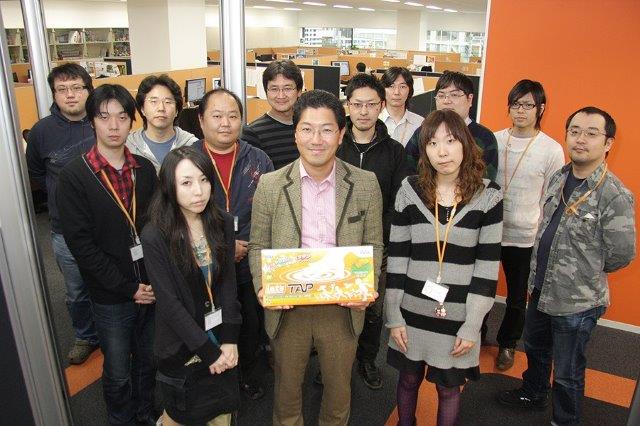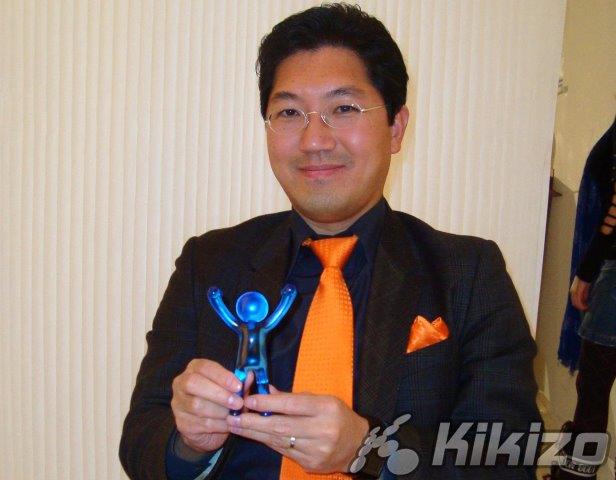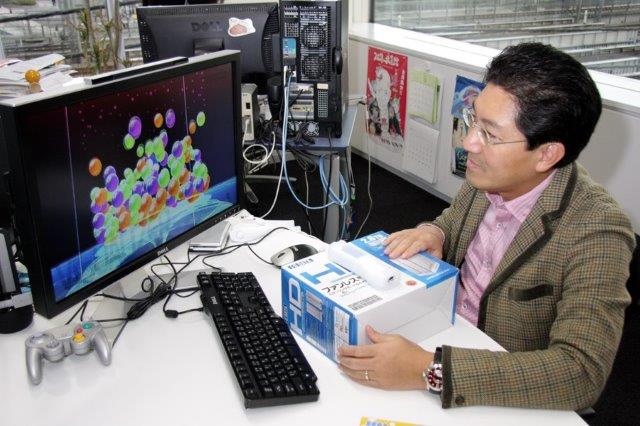

Home
Season One
About
—
Games
Daily Updates
Go Back
Daily Update - May 22nd, 2025
May 22nd, 2025
Yuji Naka Interview Supercut
For today's update, I present to you a supercut of some of my favorite Questions & Answers across four different Yuji Naka interviews conducted during the Let's Tap / Let's Catch promotional cycle. I will post the independent interviews at the bottom of the post for you to check out as well. Note that the Q&A from GAME WATCH is originally in Japanese and has been machine translated into English using a combination of Google Translate & DeepL, using context clues to attempt the most conversational & sensible English translation. Enjoy!

Kikizo: I think people were surprised when it was announced
that you'd end up working with Sega after all, having left
Sega to set up Prope. By contrast, [Tetsuya] Mizuguchi-san
(Space Channel 5, REZ) has only worked with other publishers
since leaving Sega. Why did you take this direction?
Naka: I'm not sure how it is in the western games industry,
but Japanese games development is very small. So as a creator,
once you've reached a certain point, you take on more of a
managerial position and don't get to make the games any more,
and I think that's why people like Mizuguchi-san and I go
independent and set up a new company. And so far, it's often
been the case that when these people go independent and set up
their own company, the creators sort of act 'against' the old
employer - almost like a rivalry. But I didn't have that
intention - I didn't have that kind of relationship with Sega
- so it came quite naturally for me to maintain that strong
relationship with them. And I always knew that these [Prope]
titles would be published by Sega.
Gamasutra: How many people are in Prope right now?
Naka: Right now it's about 40 staff members.

Gamasutra: Where did the idea for "Let's Tap" come
from?
Naka: It was something I came up with while we were working on
another action game. I had noticed around that time that the
Wii controller was a remarkably precise device, capable of
detecting even very small, faint vibrations.
We did a bit of a test where we placed the controller on a
desk and started tapping on the desktop around it.
Not only did the Wiimote detect that, but it also detected
when we tapped on a desk placed adjacent to the one it was
lying on.
Looking at that, I thought that it was pretty neat, that maybe
we could do something with this.
From there, I thought about how up to now, rhythm games have
been largely digital in nature -- made up of 0s and 1s
representing "off" and "on" -- but this controller could
measure more gradual levels of input in between those two
extremes.
So it was a process of discovery that ultimately led to the
idea, the idea to take a digital game and make it analog and
able to accept a wider range of input.
Game Watch: How did you find the right balance?
Naka: I had a lot of time to myself. This is a game where I
personally made all the balance adjustments by playing it. I
have always believed in myself and tried to create the game
with my own balance. When I was at Sega, I was working on so
many games that I couldn't even do the balance adjustment. In
that sense, this time around, it was very easy to adjust the
balance of the game. So it was mostly done by me and the
director, Kawarazuka. The rest was done by new employees. We
would have a lot of people play a lot of games, analyze the
data, and then say, "The balance here is rather on target",
and make minor adjustments from there.

Gamasutra: Was it difficult to find the "fun" of such a
simple interaction as this?
Naka: Well, think about it -- sometimes, do you find yourself
just idly tapping on something during the day? I know I do it
pretty much all the time, and I think everybody else does too.
So I thought about making that into a game somehow. That's
what makes this game fun, I think -- the fact that it's
something everybody does now and again.
Now, of course, there are other music and rhythm games, titles
where you're matching some kind of rhythm onscreen. But even
in the case of Guitar Hero, it's still a matter of "on" or
"off," 0 or 1. There isn't any measure of strength.
Meanwhile, with this there's a whole spectrum of strength to
the tapping. It's something that's really pretty innovative
even within the field of rhythm games.

IGN: Mini-game collections such as this are normally quite
crowded, whereas there are only five available in Let's Tap.
What's the thinking behind this?
Naka: The angle we had in mind was more like Wii Sports, so
these are five simple games but actually they can be played
for quite a long time – they're developed in a way that you go
to different levels, so even though there are only five,
there's more than meets the eye.
Game Watch: Is "Rhythm Tap" your favorite?
My favorite is the "Gem Game" in "Visualizer".
Game Watch: Why?
Naka: Maybe it's because you can play it as much as you want
while spacing out. It's a game where you don't have to think
too much. Really, you just things into a container that floats
in space. In my opinion, this is the most interesting part of
"Let's Tap." The moment I finished it, I thought, "Oh, this is
absolutely great."
Originally, the "Gem Game" was just a bouncing ball, but since
it was in the "Visualizer", I tried making it something where
you can just enjoy the changes. At first, I thought, "it's
enough to just move the ball with physics and have fun," but
then I thought, "maybe I should make it a little more
game-like," so I added the container. There used to be a
"water game"... a maze-like thing set in a container filled
with water, and when you pressed a button, the water pressure
would make rings fly into a container. This is the same kind
of game. Have you ever played something that you didn't have
to think about? I tried to make a game like that.
The goal is to make all the balls the same color, but due to
the fact that the game uses physics, sometimes the right color
ball doesn't go into the bowl. There's a balance between
frustration and "ahh" feeling of "Will it go in? Will it go
in?" that keeps me playing for tens of minutes. I can keep
playing no matter what, even if I'm in a meeting. It's a lot
of fun.
This game was so much fun that I advertised it as the "game
that even penguins can play" because you just tap. There are
surprisingly few games in the game industry that allow you to
enjoy them without concentrating and with only a little input,
other than pachinko. I want to make a game like that someday,
and I think I have created a game that's on the right track.
"Gem Game" is the best. I guess it's just my personal taste.

Gamasutra: I'd like to see some penguin
playtesting.
Naka: I sure would too!
IGN: The Let's Tap's peripheral – a cardboard box – is
gloriously lo-fi. What's your opinion on the growing amount
of more expensive peripherals on the Wii?
Naka: With games, the difference with films is the
interactivity and the ability to input. It's really a case of
what device would be required for a specific type of input,
and in this instance it just happened to be the cheapest
option – a box. In the future there will be new types of
platforms to develop new kinds of inputs.
Game Watch: You have another game, "Let's Catch", how did
this one come about?
"Let's Catch” was something I came up with when I was thinking
of a new way to use the Wii Remote. At the time, Sega was
starting to operate a darts bar, and because of that, Mr.
Oguchi (Hisao Oguchi, current director of Sega) took me to a
darts bar and taught me how to play darts. I came to like
darts so much that I set up a darts machine at home.
When I founded Prope, I played darts with everyone at Prope.
We said, "Let's make something like this". And so we made a
darts game for the Wii. It turned out pretty similar [to real
darts], but I didn't put it out in the end.
At that time, we talked about how interesting it would be to
[use the Wii Remote] to grab something and throw it. However,
the aspect of throwing proved to be difficult to turn into a
Wii game. So we started thinking, "In that case, why not grab
the ball?". We then came to the conclusion that "grabbing a
ball is just like catching a ball, isn't it?"
...
Playing catch is not just about throwing it back and forth,
there is a great deal of communication between people. You can
feel emotions change when the ball is dropped, the strength of
the throw, and you can talk about things like, "How are you
doing lately?" The back and forth of the ball is a part of the
communication between people, and that communication that
moves people's hearts. I think it's really interesting.
I don't play baseball, I don't watch live TV, and I don't play
catch, but as a game creator, I always want to make games that
move people's hearts. That is how the game "Nights" was born.
There have been many cases where people have taken on the
challenge of game creation from a similar place. "Samba de
Amigo!" was actually created from a similar challenge.
It started from darts to the idea of catching with the Wii
remote control, and then developed into a place where we
thought, "The emotional dynamics of catch are very
interesting." So, we focused on the "catching" aspect ... That
was the start of "Let's Catch", which I created in the hope
that people would be exposed to the fun of playing catch.
Kikizo: Well, we'll look forward to that. What's your
favourite game ever and why?
Naka: Lemmings. I consider the architecture and the system of
the game really quite superior. And the fact that each one of
the Lemmings has got its own designated roles and different
movements - yet their characteristics are based on real
Lemmings, so from a character design point of view also, I
find Lemmings quite fascinating.

Sources:
IGN
Kikizo
Game Developer Magazine
Game Watch:
Page One
|
Page Two
- Twitch Stream - YouTube - Patreon - Ko-Fi - Backloggd -